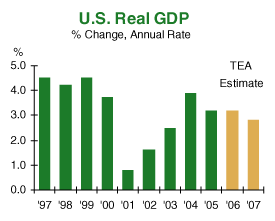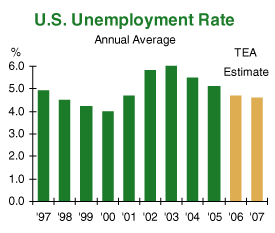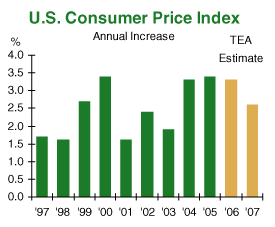|
September 13, 2006
Autumn View
Written by Jeff Thredgold, CSP, President, Thredgold Economic Associates
The American Economy
…more subdued pace
The strong 4.3% real (inflation adjusted) annual growth rate in 2006’s first half should give way to roughly a 2.7%-3.0% real growth pace over the balance of the year and into 2007. This compares to 3.2% real growth in 2005 and 3.9% growth in 2004. We don’t subscribe to the “imminent recession” view pushed by some, although odds of a recession have risen slightly.
The Federal Budget
…less red ink
Sharply higher corporate and individual tax receipts have reduced the projected budget deficit for fiscal year (FY) 2006, which ends on September 30, to near $260 billion. This compares to the $318 billion shortfall in FY2005 and the record $412 billion shortfall in FY2004. However, budget issues become more challenging in coming years.
Employment
…labor market tight
The nation’s unemployment rate averaged 4.7% during 2006’s first eight months. By comparison, the jobless rate averaged 5.3% in 2004/05 and 5.9% in 2002/03. Monthly job gains have slowed.
 Net job creation via the “official” survey of 400,000 medium- and large-sized businesses has been modest during the past 60 months, with the addition of 3.7 million new jobs. The “other” employment measure, the household survey, has recorded more than twice as many new jobs, an indication that small business job growth remains strong. Net job creation via the “official” survey of 400,000 medium- and large-sized businesses has been modest during the past 60 months, with the addition of 3.7 million new jobs. The “other” employment measure, the household survey, has recorded more than twice as many new jobs, an indication that small business job growth remains strong.
Inflation
…more market friendly
The most recent 12-month measure should be lower this month and next as big increases from last fall drop from the calculations. Overall consumer prices are expected to rise 3.2%-3.5% in 2006 as oil prices stay stubbornly high. By comparison, consumer prices rose 3.4% in 2005, 3.3% in 2004, and 1.9% in 2003. Most forecasters see 2007 consumer inflation closer to 2.5%.
The Federal Reserve
…on the sidelines?
The Federal Reserve consistently withdrew excess monetary stimulus during the past 26 months. A total of 17 consecutive 0.25% tightening moves now find the federal funds rate at 5.25%, as compared to a 46-year low of 1.00% between June 2003 and June 2004. The Fed “paused” at the August 8 FOMC meeting.
The Fed’s next meeting is September 20, with a move not expected. A further move to 5.50% is possible later, although unlikely. More talk of possible Fed ease early next year is in the market.
Long-Term Interest Rates
…recently trending lower
Mortgage rates declined by roughly 3/8% in recent weeks to near 6.45%, after reaching 4-year highs in June/July. Mortgage rates could move modestly in either direction in coming weeks, tied in part to how the stock market performs. In my aging and convoluted mind, long-term rates have peaked and will be slightly lower in 2007.
Home Prices
…pain of excess
Surging home prices of recent years on both coasts and in the Southwest have largely given way to a buyers’ market in 2006’s second half. Price weakness in select markets that went too high too fast is severe. We expect greater home price strength in the nation’s interior as relative values (compared to the coasts) are cheap.
The Global Economy
…impressive growth continues
Solid global economic growth during 2006 continues, following impressive growth during the prior three years. Solid growth for four straight years would be the first such occurrence since the early 1970s. As before, risks to this view include any major new terrorist atrocities (especially on American soil), bird flu, even higher oil prices, and a worsening of Middle East tensions.
Any discussion of the Pacific Rim must begin with Japan, a nation that still accounts for more than half of all Asian economic output and still ranks as the world’s second largest. Japan returned to modest economic growth during the past 12-18 months…following “the lost decade” of economic stagnation. Rising exports to China and stronger consumer spending have benefited the Japanese economy. The eight-year battle with deflation seems to have run its course.
Chinese real economic growth has averaged near 9.0% for 26 years (although from a very low base), the longest sustained growth for a major nation on record. China’s appetite for all types of commodities, including oil, steel, copper, and cement, which had been almost insatiable, has finally slowed a bit.
India’s economy continues to perform well, with rising success in developing world class performance. Most other economies in the Pacific Rim are performing reasonably well.
The European economy has seen some improvement, with real growth near 2.5%, the best in six years. Kingpins Germany and France still struggle with jobless rates near 11.0% and 9.0%, respectively. Despite weak economic growth, the European Central Bank has raised its key short-term interest rate four times since last fall to keep inflation at bay. Additional hikes could occur in coming months.
The Russian economy continues to take advantage of high oil prices and rising oil production. President Putin’s moves to consolidate power have the global community watching him closely. Economic decline in Africa ranks as the global community’s major failure of the past 50 years.
The South American economy has slowed somewhat. Oil-rich Venezuela remains a political powder keg, with production now in decline. Venezuela’s Castro-wannabe Chavez is trailing badly in polls for December elections.
Canadian economic growth has slowed, with no material change in employment in recent months. Unemployment at 6.5% is near a 30-year low. Energy-rich Western provinces are booming. The Mexican economy is growing at a reasonable clip, with the immigration issue raising emotions both in the U.S. and south of the border.
The Bottom Line?
U.S. economic growth during the past 36 months has been impressive. Stable growth is likely to continue. In addition, we expect: another 12-digit budget imbalance…slowing employment gains…declining inflation pressures…relative stability in both short- and long-term interest rates…soft coastal housing markets, with more solid interior performance…and an anxious but impressive global marketplace.

“Tea”ser
Three elderly gentlemen have a chat. The first says, “Let’s go to Wendy’s.”
The second says, “It’s not Wednesday, it’s Thursday.”
The third says, “Boy, I’m thirsty too.”
FYI…
We had roughly 20 people point out our spelling shortcomings in last week’s contest. We ended up sending out seven copies of Lynnette’s new CD. Her web site is www.lynnette.com.
|

